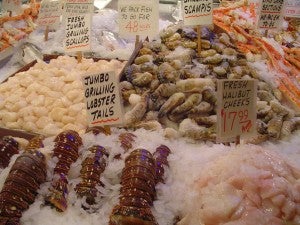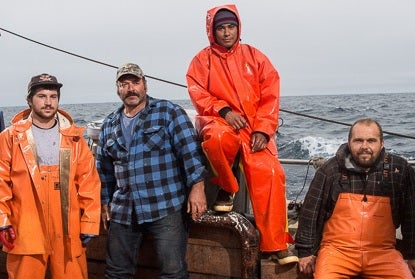
Seafood for sale at the Pike Place Market in Seattle, WA. Photo: Kate Culzoni
Squandering ocean fish—an essential living resource—unnecessarily harms not only wild creatures, but also the billions of people around the world dependent upon fish for their food and livelihoods.
A recent report by the Johns Hopkins Center for a Livable Future finds that between 2009 and 2013, billions of pounds of seafood is wasted every year in the United States—that’s as much as 47% of all edible seafood going to waste. The waste occurs throughout the seafood supply chain, but also in wild fish discarded at sea, sometimes called “bycatch” or “discards.” Fortunately, there are good answers to the bycatch part of this challenge.
Proven solutions exist to reduce wasted fish in the form of bycatch and discards. When fishermen are empowered with sustainable management, they are able to focus on gear and harvesting innovations that target only the fish they want to catch.
In fact, catch shares, a proven tool that aligns environmental and economic incentives for fishermen, save enough fish from being discarded to feed 17 million Americans their seafood for an entire year.
West Coast fishermen are innovating to reduce waste:
Take one example from the U.S. West Coast. In the early 2000s, a very large trawl fishery targeting multiple species of groundfish—such as

W. Coast fishermen like Joe Penissi are innovating for more sustainably caught seafood. Photo: Corey Arnold
rockfish and sole—was decimating populations of many slow-growing fish species. Strict regulations on which ones could be kept, and decisions by fishermen to keep only the largest and/or more valuable fish (sometimes called “high-grading”), resulted in frequent discarding of unwanted dead fish at sea. This practice had severe ecological and economic consequences, including a formal federal disaster declaration.
Intense collaborative work between fishermen, managers, scientists and NGO experts led to the adoption of a high-performance catch share in 2011 that features incentives for avoiding depleted species, which has cut their accidental catch dramatically and substantially reduced overall discarding of dead fish at sea. At the same time, this new management plan established a system of 100% catch monitoring, which ensures the accounting of every fish that comes over the rail.
This combination spurred an innovation boom within the trawl fishery, which is reducing its footprint, staying out of sensitive areas, testing new gear, and exchanging bycatch information in real time to avoid overfished and depleted species. As a result, approximately 70% of West Coast flounder and sole and 60% of rockfish now qualify as a Seafood Watch Best Choice. Now, 20 species caught under this system have been certified sustainable by the Marine Stewardship Council, producing about 40 million pounds of high-quality, low-waste seafood.
Recently, a West Coast fisherman was featured in KQED for his low impact trawl gear—which he was able to capture on a Go Pro camera. His net is “light touch,” which means that it operates above the sea floor and allows juvenile fish to escape before the net is brought on board. Innovations like this are possible because fishermen operating under catch shares management have more time to focus on how they can make their business more efficient and sustainable.
More progress needs to be made:
The U.S. Southeast still uses ineffective management tools (like size and bag limits and closed seasons) to manage many reef fishes for individual species, while still allowing fishing for others, guaranteeing that many dead fish must be dumped back dead into the sea. Many species of vulnerable groupers and sharks are managed solely through a landings prohibition that requires every single one caught to be dumped, dead or alive, without effectively managing how many are killed.
Even there, the high-quality catch share for commercial red snapper and a variety of groupers and tilefishes in the Gulf of Mexico speaks to a better day ahead, in terms of wild seafood waste and economics of fishing. A novel trial for red snapper addressing part of the recreational fishery shows that similar approaches there hold great potential for reducing current large waste in that sector.
Overall, the U.S. has made progress on reducing bycatch, while still landing safe, fresh fish. Nationwide, bycatch rates are falling. A further update to the U.S. national bycatch report is due out this year, and a comprehensive report is expected in 2017.
Time and again, it has been our experience that fishermen hate to see fish go to waste more than anyone—and that when empowered with the right tools like catch shares—not only does waste decrease, but innovation increases.









